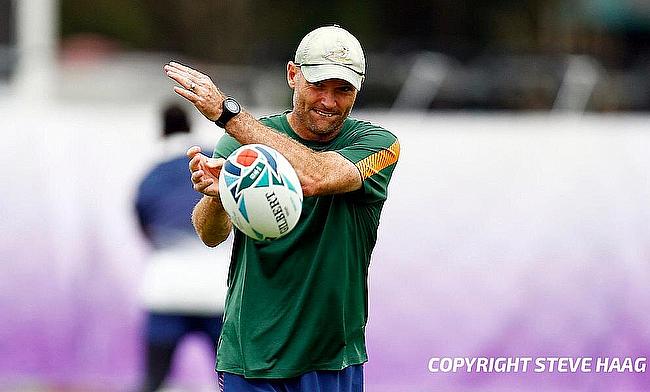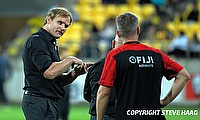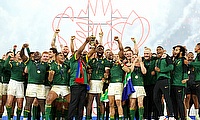Will South Africa's 7-1 split catch on - and will the Springboks deploy it at the World Cup?

South Africa put down a marker against New Zealand after a powerful showing at Twickenham
©Steve Haag
On Friday night, South Africa reminded everyone why they are the reigning holders of the World Cup and why they should not be at all underestimated over the next six weeks in France.
In their 35-7 victory over Rugby Championship winners New Zealand, the Springboks dominated up front, demonstrating the power that sets them apart.
In the past decade, how 'replacements' have been used has become more and more of a tactical weapon in Test rugby, with teams choosing to load their bench with forwards in a ‘6-2 split’, as opposed to the classic 5-3 that has been standard since eight-man benches came into the game. It was South Africa's ‘bomb squad’, as it was aptly described, that bulldozed their way through everyone in Japan four years ago.
In the lead up to the tournament in France, the Boks have used their bench as other teams have, to test out as many players as possible, and Friday was no different.
That was until the late withdrawal of Willie le Roux.
Jacques Nienaber chose to replace the full-back with Kwagga Smith (a flanker), to create a 7-1 split with former Northampton Saint Kobus Reinach as the single back replacement.
So, did the experiment work, and perhaps more interestingly, will it catch on in the Test rugby arena?
The answer to the first question is simple. Yes. The Boks forwards were able to completely empty their tank for 47 minutes, at which point seven of their eight forwards were replaced with an almost entirely fresh pack. The single survivor was flanker Pieter-Steph du Toit. Their dynamism and power in the second half was staggering, and the normally strong All Blacks side had nothing that could match it.
Will it catch on?
The major drawback of naming such a lopsided substitutes bench is that it is a risk. Should an injury (or two) happen in the backs, the team is suddenly starting to plug holes and perhaps someone with little experience is then asked to step into a very important position. For instance, if Canan Moodie pulled his hamstring after five minutes, suddenly Reiko Ioane and co have 75 minutes to run at someone who is far from a 13 in Reinach - or however the Boks choose to rejig their backs.
But, times are changing, and plenty of players these days would be handy in both the forwards and the backs with Ben Earl, Ardie Savea and Juan Martin Gonzalez a few examples who have the skill set that could work nicely in the back row as well as the centres.
There are instances where a rejig has happened, and worked. Last November, in perhaps the highest-quality game of this World Cup cycle, Sekou Macalou (normally a back-rower) played on the wing for France against South Africa - and was excellent.
Then there is a man who is genuinely world-class in both positions; Fiji's Levani Botia. Being able to call on him off of a 7-1 bench would be excellent, and it suits him perfectly. Ronan O’Gara would surely have tried it at La Rochelle, should Botia not be one of the first names on the team sheet.
The second major drawback of the 7-1 split is the consistency issues that arise. For instance, the logical option would be to spread the substitutes out across the second half but that means it would be hard to keep any rhythm in a team if you were bringing on seven different players all at different times.
Players play better when they are used to the intricacies of how their teammates operate, particularly in specific high-skill areas such as front-row scrummaging.
South Africa have always had an interesting response to this, by having a very clear starting pack and bench pack. Malcolm Marx is the prime example. He has been within the top two hookers in the world for six years now and yet has only started 33 out of 63 games for his country with most of those being over the transitional last two years.
Perhaps the most critical reason why a 7-1 bench split will never catch on though, is that all other international teams (possibly barring France) simply don’t have the forward depth for the rewards to outweigh the risks. South Africa’s second and third-choice pack could beat most international teams, with some tier-one nations having major depth issues in that department.
So will it catch on? Probably not. Was it fun to see Bongi Mbonambi and co. limbering up to come on and massacre the All Blacks on Friday? Yes.
We’ll just have to mark it down as something we see in the warm-ups compared to a tournament, but wouldn’t see if the pressure were on. However, just imagine the Boks make it to the World Cup final and name a bench they know will terrify whoever the opponent is?
Box. Office.









